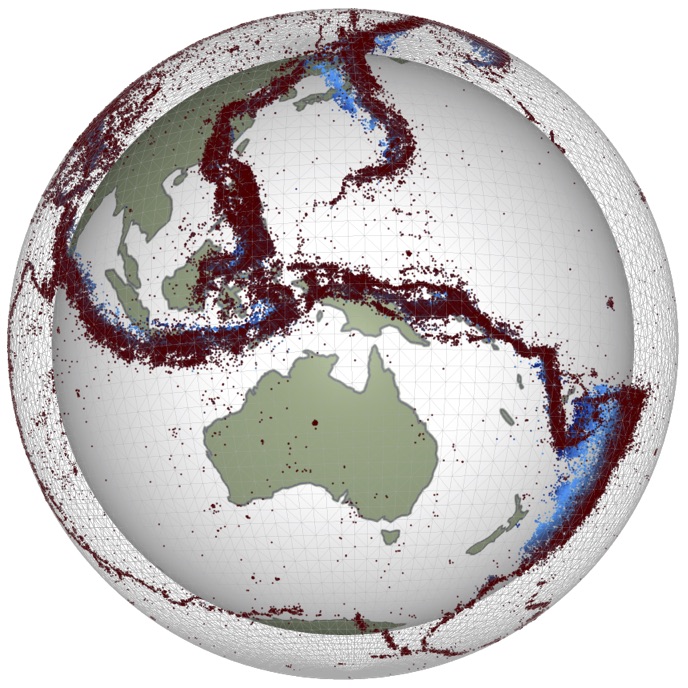# to fix trame issue
import nest_asyncio
nest_asyncio.apply()
Periodic Mesh Example (WIP)#
This is a periodic, Cartesian mesh with the periodic bcs specified using gmsh itself. Compare this to the Cylindrical Stokes example that has periodic coordinates in a mesh that is continuously connected.
Generate Periodic mesh using GMSH#
# %%
import gmsh
gmsh.initialize()
# %%
gmsh.model.add("Periodic x")
# %%
minCoords = (0.0, 0.0)
maxCoords = (1.0, 1.0)
cellSize = 0.1
# %%
boundaries = {
"Bottom": 1,
"Top": 2,
"Right": 3,
"Left": 4,
}
# %%
xmin, ymin = minCoords
xmax, ymax = maxCoords
# %%
p1 = gmsh.model.geo.add_point(xmin, ymin, 0.0, meshSize=cellSize)
p2 = gmsh.model.geo.add_point(xmax, ymin, 0.0, meshSize=cellSize)
p3 = gmsh.model.geo.add_point(xmin, ymax, 0.0, meshSize=cellSize)
p4 = gmsh.model.geo.add_point(xmax, ymax, 0.0, meshSize=cellSize)
l1 = gmsh.model.geo.add_line(p1, p2, tag=boundaries["Bottom"])
l2 = gmsh.model.geo.add_line(p2, p4, tag=boundaries["Right"])
l3 = gmsh.model.geo.add_line(p4, p3, tag=boundaries["Top"])
l4 = gmsh.model.geo.add_line(p3, p1, tag=boundaries["Left"])
cl = gmsh.model.geo.add_curve_loop((l1, l2, l3, l4))
surface = gmsh.model.geo.add_plane_surface([cl])
# %%
gmsh.model.geo.synchronize()
# %%
translation = [1, 0, 0, 1, 0, 1, 0, 0, 0, 0, 1, 0, 0, 0, 0, 1]
# %%
gmsh.model.mesh.setPeriodic(1, [boundaries["Right"]], [boundaries["Left"]], translation)
# %%
# Add Physical groups
for name, tag in boundaries.items():
gmsh.model.add_physical_group(1, [tag], tag)
gmsh.model.set_physical_name(1, tag, name)
gmsh.model.addPhysicalGroup(2, [surface], surface)
gmsh.model.setPhysicalName(2, surface, "Elements")
# %%
gmsh.model.mesh.generate(2)
gmsh.write("tmp_periodicx.msh")
gmsh.finalize()
Import Mesh into PETSc#
# %%
from petsc4py import PETSc
import underworld3 as uw
from underworld3.systems import Stokes
import numpy as np
options = PETSc.Options()
# %%
plex = PETSc.DMPlex().createFromFile("tmp_periodicx.msh")
# %%
for name, tag in boundaries.items():
plex.createLabel(name)
label = plex.getLabel(name)
indexSet = plex.getStratumIS("Face Sets", tag)
if indexSet:
label.insertIS(indexSet, 1)
else:
plex.removeLabel(name)
plex.removeLabel("Face Sets")
# %%
plex.view()
# %%
from underworld3.discretisation import Mesh
# %%
mesh = Mesh(plex, degree=1)
# %%
mesh.dm.view()
# %%
swarm = uw.swarm.Swarm(mesh=mesh)
material = uw.swarm.IndexSwarmVariable("M", swarm, indices=2, proxy_degree=1)
swarm.populate(fill_param=3)
Create Stokes object
v = uw.discretisation.MeshVariable("U", mesh, mesh.dim, degree=2)
p = uw.discretisation.MeshVariable("P", mesh, 1, degree=1)
stokes = uw.systems.Stokes(mesh, velocityField=v, pressureField=p)
stokes.constitutive_model = uw.constitutive_models.ViscousFlowModel
stokes.constitutive_model.Parameters.viscosity = 1
# No slip boundary conditions
stokes.add_dirichlet_bc((0.5, 0.0), "Top", (0, 1))
stokes.add_dirichlet_bc((-0.5, 0.0), "Bottom", (0, 1))
# %%
# Write density into a variable for saving
densvar = uw.discretisation.MeshVariable("density", mesh, 1)
with mesh.access(densvar):
densvar.data[:, 0] = 1.0
# %%
swarm.dm.getCoordinates().array
# %%
# body force
import sympy
x, y = mesh.X
unit_rvec = mesh.rvec / sympy.sqrt(mesh.rvec.dot(mesh.rvec))
stokes.bodyforce = 0 * mesh.X # -mesh.X / sympy.sqrt(x**2 + y**2)
# %%
# Solve time
stokes.solve()
mesh.petsc_save_checkpoint(index=0, meshVars=[stokes.u, stokes.p, densvar], outputPath='./output/')
swarm.petsc_save_checkpoint(swarmName='swarm', index=0, outputPath='./output/')
check if that works
if uw.mpi.size == 1:
import pyvista as pv
import underworld3.visualisation as vis
pvmesh = vis.mesh_to_pv_mesh("tmp_periodicx.msh")
# pvmesh.point_data["V"] = vis.vector_fn_to_pv_points(pvmesh, v.sym)
velocity_points = vis.meshVariable_to_pv_cloud(v)
velocity_points.point_data["V"] = vis.vector_fn_to_pv_points(velocity_points, v.sym)
pl = pv.Plotter(window_size=(1000, 750))
pl.add_mesh(pvmesh, "Black", "wireframe")
# pl.add_arrows(pvmesh.points, pvmesh.point_data["V"], mag=5.0e-1, opacity=0.5)
pl.add_arrows(velocity_points.points, velocity_points.point_data["V"], mag=5.0e-1, opacity=0.5)
pl.show(cpos="xy")
if uw.mpi.size == 1:
import pyvista as pv
import underworld3.visualisation as vis
pvmesh = vis.mesh_to_pv_mesh("tmp_periodicx.msh")
pvmesh.point_data["V"] = vis.vector_fn_to_pv_points(pvmesh, v.sym)
# velocity_points = vis.meshVariable_to_pv_cloud(v)
# velocity_points.point_data["V"] = vis.vector_fn_to_pv_points(velocity_points, v.sym)
pl = pv.Plotter(window_size=(1000, 750))
pl.add_mesh(pvmesh, "Black", "wireframe")
pl.add_arrows(pvmesh.points, pvmesh.point_data["V"], mag=5.0e-1, opacity=0.5)
# pl.add_arrows(velocity_points.points, velocity_points.point_data["V"], mag=5.0e-1, opacity=0.5)
pl.show(cpos="xy")

